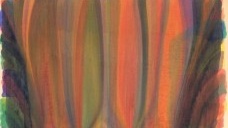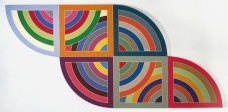
newspaper
agenda cultural
The shift from the postwar anxiety of the fifties to the vibrancy and confidence of the early sixties was mirrored by a similar transition in the visual arts. Many young painters in America began to turn away from the hallmarks of Abstract Expressionism, particularly its emphasis on gesture and emotive content. They moved in two general directions: a radically optical style later termed “Color Field painting,” and an image- based style called “Pop art,” which adapted material from the mass media. The Solomon R. Guggenheim Museum, New York, acquired several examples of Color Field painting at the time they were created and featured them in landmark exhibitions of the sixties and seventies. The thirteen artists in the current exhibition are among those included in these past presentations.
Large-scale canvases by Helen Frankenthaler, Morris Louis, and Jules Olitski exemplify the flat expanses of color often stained into (rather than painted onto) the support that were characteristic of certain artists of this era. These artists and their contemporaries, in spite of their differences in technique—some applied paint with a traditional brush, while others poured, rolled, soaked, or sprayed their pigments—all explored the nuances and power of color at a moment when the United States was embracing the energy of the youth, as well as trying to break free from the tumult of the previous decades.

Morris Louis, Saraband, 1959. Acrylic resin on canvas, 256.9 × 378.5 cm. Solomon R. Guggenheim Museum, New York 64.1685. © Morris Louis

Frank Stella, Harran II, 1967. Polymer and fluorescent polymer paint on canvas 10 x 20 feet. Solomon R. Guggenheim Museum, New York. Gift, Mr. Irving Blum, 1982

